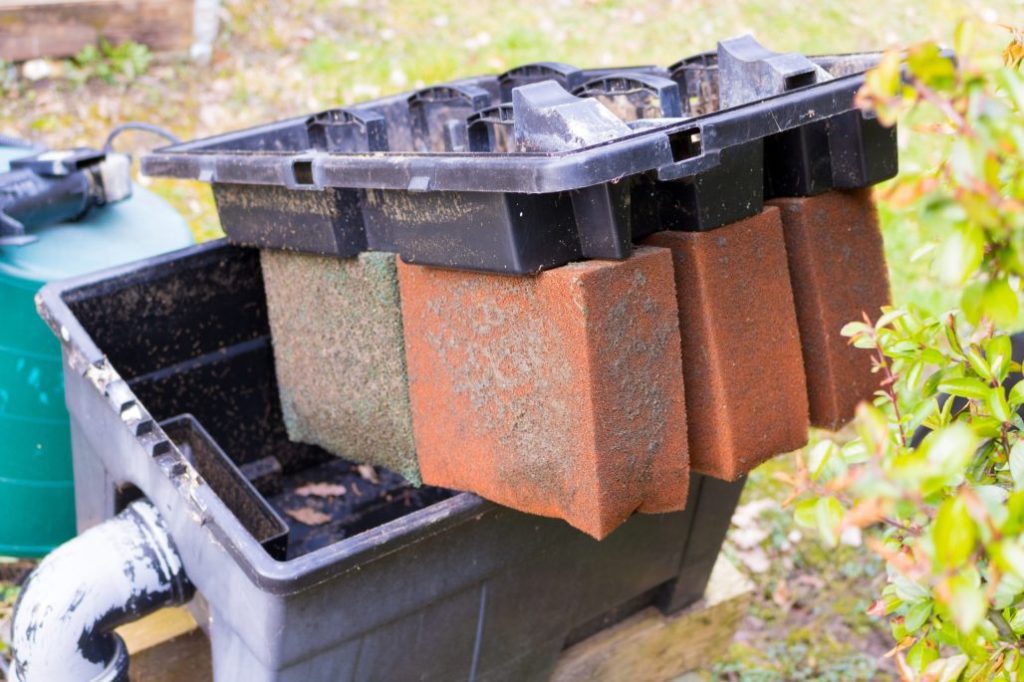
Top Tips: What You Need to Know About Pond Filtration
Maintaining a healthy pond requires understanding what you need to know about pond filtration. Proper filtration removes debris and toxins, making the water safe for fish and plants. This article covers the basics of mechanical, biological, and UV filtration, and guides you on selecting the right filter for your pond’s size and needs.
Key Takeaways
Pond filtration consists of mechanical, biological, and UV components that work together to maintain water quality and a healthy environment for fish and plants.
Choosing the right pond filter depends on the pond’s size, fish load, and maintenance preferences, with options like all-in-one, box, pressurized, and koi filters available.
Regular maintenance, including cleaning and monitoring filter media, is essential to ensure optimal filtration performance and prevent water quality issues.
Understanding Pond Filtration Basics

Pond filtration balances water quality and supports aquatic life. The main purpose of a pond filter is to create healthy pond water for fish and plants by removing visible debris and toxic chemicals. Pond filters can be classified into three primary types: biological, mechanical, and UV clarifiers, each serving a unique function in maintaining a healthy pond ecosystem.
Mechanical filtration removes physical waste and debris, while biological filtration breaks down waste into less harmful compounds. UV filtration, on the other hand, is primarily used to control green pond water caused by algae, ensuring clear water by eliminating free-floating algae and harmful pathogens.
Knowing these basic filtration types and their roles is fundamental to effective pond management. Each type contributes to the overall health and clarity of your pond, making it a thriving habitat for your fish and plants.
Mechanical Filtration
Mechanical filtration is the first line of defense in a pond filtration system. Its primary function is to trap and remove debris and sediment, preventing the build-up of organic material that can lead to poor water quality. This type of filtration uses various media, such as filter brushes, sponges, and vortex systems, to physically capture waste. For instance, in a box skimmer, water is captured in the skimmer basket and filtered through a horizontal mat, effectively removing leaves and fish waste.
However, mechanical filtration alone is not enough to maintain a healthy pond. It must be combined with biological filtration to manage fish waste, uneaten food, and other organic components. Mechanical and biological filters together ensure effective removal of both solid and dissolved wastes from the pond water.
Biological Filtration
Biological filtration is a critical component of any pond filtration system. It involves the use of beneficial bacteria to convert harmful ammonia, produced by fish waste and other organic matter, into less toxic substances like nitrites and nitrates. This process, known as the nitrogen cycle, is essential for maintaining a safe and healthy environment for pond fish.
Biological filtration is a critical component of any pond filtration system. It involves the use of beneficial bacteria to convert harmful ammonia, produced by fish waste and other organic matter, into less toxic substances like nitrites and nitrates. This process, known as the nitrogen cycle, is essential for maintaining a safe and healthy environment for pond fish.
Regular application of beneficial bacteria, especially during the spring, can boost biological activity and support the natural filtration process.
UV Filtration
UV filtration is an effective method for controlling green pond water caused by algae. UV filters, also known as ultraviolet clarifiers, work by passing pond water through a tube containing an ultraviolet bulb that kills microscopic particles. This process sterilizes the water, eliminating free-floating algae and harmful pathogens, which helps maintain clear water.
While UV filters are excellent for achieving clear water, they should be used in conjunction with mechanical and biological filters for comprehensive pond filtration. Integrating UV filtration into your pond system effectively manages algae and ensures a balanced and healthy pond environment.
Types of Pond Filters

Choosing the right pond filter is key to maintaining a healthy pond. There are various types of pond filters available, each designed to meet different needs and preferences. The main types include all-in-one filters, box filters, pressurised filters, and koi filters. Each type has its unique advantages and is suited to specific pond conditions and sizes.
All-in-one pond filters integrate mechanical, biological, and UV filtration methods into a single unit, making them a convenient choice for small ponds with minimal fish loads. Box pond filters, on the other hand, use gravity to return filtered water to the pond, making them efficient for various pond sizes.
Pressurised pond filters are ideal for medium to large ponds and can handle higher fish loads, while koi pond filters are specifically designed to manage the large quantities of waste produced by koi fish.
All-in-One Pond Filters
All-in-one pond filters are a popular choice for small, lightly-stocked ponds. These filters integrate mechanical, biological, and UV filtration methods into a single, compact unit, making them space-efficient and easy to maintain. They are designed to handle minimal fish loads, providing adequate filtration to keep the pond water clean and clear.
The integration of beneficial bacteria in all-in-one filters helps decompose organic matter, significantly improving water quality. This makes them an excellent option for pond owners looking for a straightforward and effective filtration solution.
Box Pond Filters
Box pond filters are another efficient option for pond filtration. These filters operate by using gravity to return filtered water to the pond, ensuring a natural flow and efficient water circulation. The outlet of a box filter must be positioned above the water level to facilitate this gravity-fed return.
Box pond filters are suitable for various pond sizes and can handle moderate fish loads. By utilizing underground pipes or streams, these filters can effectively return filtered water to the pond from an underground filter, enhancing the overall efficiency of the fish pond filters and pond filtration system.
Pressurised Pond Filters
Pressurised pond filters are ideal for medium to large ponds, especially those with higher fish loads. These filters pump water under pressure through various filtration media and a UV clarifier, ensuring thorough filtration before returning the water to the pond. This design allows a pressurised pond filter to be placed anywhere outside the pond, providing flexibility in installation and the ability to feed water features such as waterfalls.
The robust design and high filtration capacity of pressurised pond filters make them an excellent choice for pond owners looking to maintain clear, healthy pond water.
Koi Pond Filters
Koi pond filters are specifically engineered to handle the high waste levels generated by koi fish. These filters are designed to manage large quantities of fish waste, maintaining a healthy environment for the fish. Koi pond filters must handle high biological loads to ensure the water remains clear and safe for the koi.
For koi pond owners, investing in a specialized koi pond filter is essential to maintain a clean and healthy pond environment. These filters are built to provide the necessary filtration capacity to support the unique needs of koi fish.
Choosing the Right Pond Filter

Selecting the right pond filter involves considering several factors, including the pond’s size, shape, water capacity, and the specific needs of the pond’s ecosystem. Matching the filter to the pond’s characteristics and intended use is crucial for optimizing filtration and maintaining a healthy pond environment.
Effective filtration requires the filter to process 150% of the pond’s water volume and handle the entire water volume at least once every hour. Regular maintenance is also essential to prevent clogs and ensure the filter operates efficiently.
Considering Pond Size and Shape
The size and shape of your pond play a significant role in filter selection. Important factors to consider include the pond’s water capacity, the number of fish, and the presence of pond plants. Pressurised pond filters are particularly suited for medium to large ponds and can handle higher fish loads due to their ability to pump water under pressure.
Pressurised filters’ flexible placement allows them to power features like waterfalls, enhancing your pond’s aesthetic appeal. Ensuring that the filter matches the pond’s size and shape is crucial for maintaining healthy pond water.
Maintenance Requirements
The amount of maintenance required for a pond filter is an essential factor to consider when choosing one. Regular cleaning is vital for maintaining clear water and a healthy pond ecosystem.
DIY pond filters require minimal maintenance, making them highly convenient for pond owners.
Water Clarity Goals
Desired water clarity can dictate the type of filtration system necessary for optimal pond health. Specific filtration systems can achieve varying levels of water clarity, and users should identify their desired clarity beforehand.
They are particularly beneficial for maintaining clear water in medium to large ponds.
DIY Pond Filtration Tips

Crafting your own pond filter can significantly reduce expenses while retaining an aesthetic appeal. DIY pond filters offer a cost-effective solution for maintaining a healthy pond without compromising on performance.
Creating an effective DIY pond filter involves selecting the right materials and size ratios to ensure proper filtration. Easily sourced materials, such as food-safe storage containers and heavy-duty plastic totes, can be used to build a functional and efficient DIY pond filter.
Equipment for DIY Pond Filters
Choosing the right materials is crucial to building effective DIY pond filters. For small ponds, containers should be 10% of the overall pond volume, providing a good starting point for filter volume or surface area. Utilizing the right materials and size ratios will ensure a functional and effective DIY pond filter system.
Easily sourced materials, such as food-safe storage containers and heavy-duty plastic totes, can be used to create a DIY pond filter. These materials are not only cost-effective but also durable and reliable for long-term use.
Step-by-Step Guide to Building a DIY Pond Filter
Building a DIY pond filter can be a rewarding project. The four fundamental points for designing a DIY pond filter are to remove solids, slow the water, move slow water through bacteria-colonized areas, and add plants.
Start by choosing a suitable container and creating a water dispersal system using a PVC pipe with multiple holes to ensure proper water flow and prevent back pressure on the pump. Place the filter media, such as bricks or rocks, to support the water dispersal pipe and create areas for bacteria to colonize.
Gravity can be used to facilitate the return of filtered water to the pond from underground filtration systems, ensuring a continuous and effective filtration process. Adding a simple tap can help in removing solids in a small pond system, making maintenance easier.
Maintaining Your DIY Pond Filter
Minimal upkeep is required for DIY pond filters, which helps maintain their efficiency and functionality. Regular cleaning and maintenance of your DIY pond filter can greatly improve the quality of your pond water, ensuring a healthy and thriving pond ecosystem.
Cleaning and Maintaining Pond Filters
Regular maintenance is crucial for the optimal operation of pond filters. It helps ensure that they run smoothly and effectively. The maintenance frequency of a pond filter is closely related to the pond’s pollutant levels and the number of fish present. Regular cleaning of pond filters is crucial for optimal performance, as it prevents clogs and ensures efficient operation. Some filters require more frequent cleaning and media replacement, impacting their overall usability.
For those with busy schedules, some filtration systems are designed with self-cleaning features, significantly reducing the maintenance effort. Regardless of the type of filter, establishing a regular maintenance schedule is key to maintaining a healthy pond.
Cleaning Mechanical Filters
Cleaning mechanical filters thoroughly is crucial to prevent reduced water flow. To clean mechanical filter media, remove it and rinse until clear water flows, using a strong water stream to remove debris. Regular maintenance of mechanical filters ensures they continue to trap and remove debris effectively, maintaining optimal water quality.
Mechanical filters should be cleaned frequently to ensure they do not become clogged and reduce the efficiency of the mechanical pond filters and pond filtration system. This will help produce waste-free, clear, and healthy pond water.
Cleaning Biological Filters
Cleaning biological filters requires a different approach to preserve beneficial bacteria essential for water quality. To clean biological filters, maintain regular cleaning until sludge is no longer visible, exclusively using water from the pond. Swishing the media in dirty pond water protects the beneficial bacteria that play a crucial role in breaking down harmful substances.
Using pond water for cleaning biological filters helps maintain the beneficial bacteria, ensuring the biological filtration process continues to operate effectively. This practice is crucial for sustaining a healthy pond ecosystem.
When to Replace Filter Media
Filter media should be replaced when it shows signs of excessive wear or degradation to sustain effective filtration. Regularly monitoring filter media condition is crucial for maintaining a healthy pond ecosystem, as failing to replace worn filter media can lead to reduced water quality and ineffective filtration.
Keeping a close eye on the condition of your filter media ensures your pond filtration system continues to function optimally.
Enhancing Filtration with Plants

Aquatic plants naturally purify water, playing a vital role in boosting pond filtration. These plants filter sediments, absorb toxins, and reduce nutrient levels in the water, helping maintain a healthy ecosystem. A diverse range of plants in a pond can enhance filtration effectiveness and improve water quality.
Submerged and marginal plants not only contribute to filtration but also provide food, shade, and shelter for fish and wildlife. If excess nutrients in the pond are not removed, they can lead to algae growth, resulting in green water and poor water quality.
Best Plants for Pond Filtration
Aquatic plants are essential for a pond’s ecosystem as they absorb nitrates during their growth and aid in the breakdown of waste. Recommended marginal plants for improving pond filtration include Louisiana iris, canna lilies, and rushes. These plants should be planted in gravel and rocks for better growth, but care must be taken to avoid plants with roots that disrupt sediment.
Excessive nitrates can cause algae blooms, which harm fish; a variety of plants ensures consistent growth and effective nitrate absorption. Incorporating a mix of plants in your pond can significantly enhance water quality and overall pond health.
Planting Techniques
Aquatic plants can be effectively anchored in gravel and rocks to promote stability and growth. While soil can accelerate plant establishment, it may contribute to excess nutrients leading to algae blooms. Using gravel and rocks helps control nutrient levels and supports the health of your pond ecosystem.
The Role of Beneficial Bacteria in Pond Health
Beneficial bacteria maintain pond health by breaking down harmful substances such as ammonia and nitrites. A suitable surface area for filter media can enhance the growth of beneficial bacteria in pond filters.
Recommended types of rocks that can house beneficial bacteria in DIY pond filters include scoria, lava rock, and aquaponic clay balls.
Nitrogen Cycle and Its Importance
The nitrogen cycle maintains water health by converting harmful ammonia into less toxic substances, ensuring a balanced ecosystem. Beneficial bacteria in ponds colonize rocks and gravel, breaking down harmful substances like ammonia into nitrite and then into nitrate. Ammonia and nitrite, both toxic to fish, are converted by bacteria into nitrate, which is less harmful and can support aquatic plant life.
De-nitrification occurs in anaerobic areas of the pond, converting nitrates back to nitrogen gas, effectively removing excess nitrogen from the water.
Adding Bacteria to Your Pond
Adding beneficial bacteria to your pond is essential for maintaining a balanced ecosystem. Beneficial bacteria need surfaces like rocks and gravel in the pond filter to grow effectively. Adding beneficial bacteria after establishing proper surfaces will help maintain a balanced environment in your pond.
These bacteria play a crucial role in breaking down harmful substances in pond water, supporting a healthy ecosystem.
Summary
Understanding and implementing effective pond filtration is essential for maintaining a healthy and beautiful pond. From mechanical to biological to UV filtration, each type plays a vital role in ensuring clear water and a thriving ecosystem. Choosing the right filter, whether it’s an all-in-one, box, pressurised, or koi filter, depends on your pond’s specific needs and characteristics.
Regular maintenance, including cleaning and replacing filter media, is crucial for the long-term success of your pond filtration system. Enhancing filtration with plants and beneficial bacteria further supports water quality and overall pond health. With the right knowledge and tools, you can create and maintain a naturally balanced pond that will be a joy to behold.
Frequently Asked Questions
Why is pond filtration important?
Pond filtration is crucial for maintaining water quality by removing debris and toxins, which supports the health of aquatic life. Proper filtration ensures a balanced ecosystem, promoting a thriving pond environment.
What are the main types of pond filters?
The main types of pond filters include mechanical, biological, and UV clarifiers, each playing a crucial role in ensuring your pond remains healthy and clear. Choosing the right combination is essential for effective pond maintenance.
How often should I clean my pond filter?
Cleaning your pond filter should be done regularly, with the frequency influenced by pollutant levels and fish population. Aim for at least once a month or more often if necessary to maintain optimal performance.
Can I use plants to enhance pond filtration?
Yes, using aquatic plants significantly enhances pond filtration by naturally purifying water, filtering sediments, and absorbing toxins and excess nutrients.
What role do beneficial bacteria play in pond health?
Beneficial bacteria are crucial for pond health as they break down harmful substances like ammonia and nitrites, ensuring a balanced ecosystem that supports the wellbeing of fish and aquatic plants.



